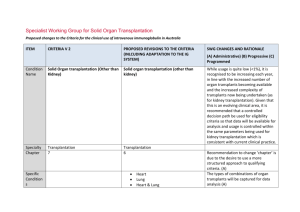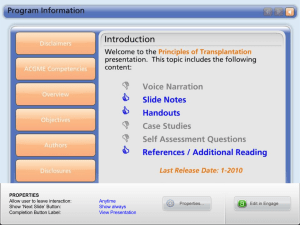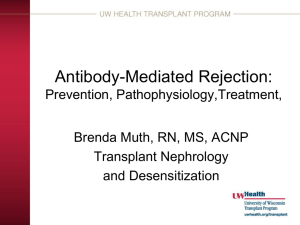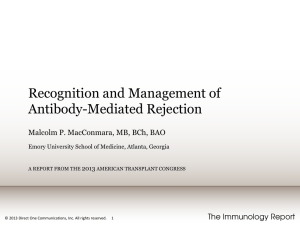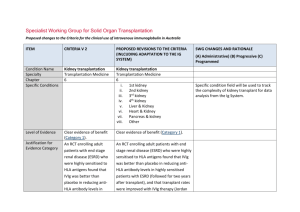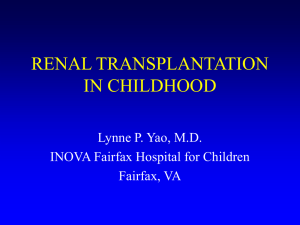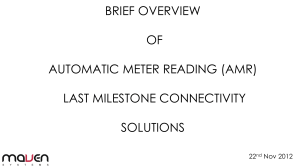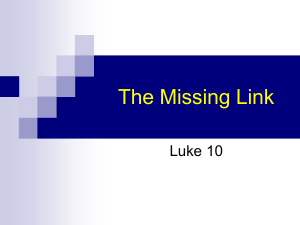Renal Allograft Rejection B (final october 2014)
advertisement
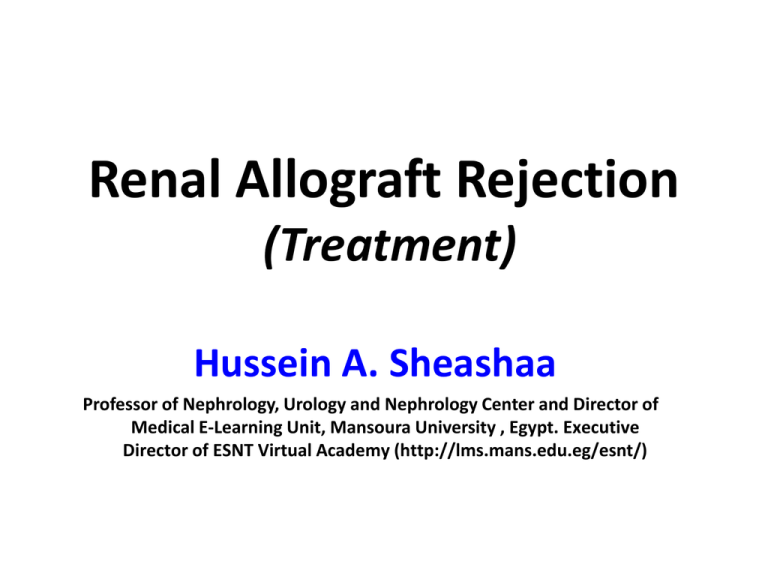
Renal Allograft Rejection (Treatment) Hussein A. Sheashaa Professor of Nephrology, Urology and Nephrology Center and Director of Medical E-Learning Unit, Mansoura University , Egypt. Executive Director of ESNT Virtual Academy (http://lms.mans.edu.eg/esnt/) Cell Mediated Rejection KDIGO: Chapter 6: Treatment of Acute Cellular Rejection American Journal of Transplantation 2009, Volume 9, suppl 3 Response of ACMR to Anti rejection treatment Wu et al. Transplantation 2014;97: 1146-1154 Late Acute Cellular Rejection (after 90 days): 355 episodes in a cohort of 5758 patients A total of 215 patients had 1 episode, 57 had 2 episodes, and 13 had 3 episodes of LAR. The prevalence and recurrence of LAR are considerable and associated with increased incidence of graft loss. Rodrigues et al. Transplantation 2014 May 12 Impact of the presence of a Humoral Component with Acute Cellular Rejection (147 Cases: Pure ACR/Mixed 92 /55) Willicombe et al. Transplantation 2014;97: 433-439 Antibody Mediated Rejection Antibody Mediated Rejection Worsens graft Survival Lefaucheur, et al. Lancet 2013; 381: 313–19 Strategies to prevent AMR The ideal regimen for the prevention of ABMR in sensitized patients remains unknown. Djamali et al American Journal of Transplantation 2014; 14: 255–271 Strategies to prevent AMR Strategies to minimize the risk for de novo DSA should be a mandatory part of clinical management: o Allocation points for class II matching, o Avoiding drug minimization in patients at risk for de novo DSA [i.e. class II mismatch, or early TCMR], o Early recognition of nonadherence Desensitization Mengel et al. American Journal of Transplantation 2014; 14: 524–530. Prevention of AMR Vo et al. Transplantation 2014 Aug 15;98(3):312-9. Prevention of Chronic AMR Prevention, rather than treatment appears to be a more effective option for reducing the incidence of C-AMR Plasmapheresis, IVIG, and Rituximab seems the most effective of current desensitization protocols Strategies to prevent AMR: Why Donor Exchange? Nephrology Self-Assessment Program - Vol 10, No 6, November 2011 Therapy options for Acute AMR The suppression of the T-cell–dependent antibody response (steroids, cyclosporine, tacrolimus, and sirolimus). The removal of donor reactive antibody (plasmapheresis). The blockade of the residual allo-antibody (IvIg). The depletion of naive and memory B cells (rituximab). Inactivation of plasma cells (bortezomib). The blockade of complement component C5 by monoclonal antibodies (eculizumab). Kidney International (2012) 81, 628–639 Treatment of Acute AMR: KDIGO Guidelines 2C American Journal of Transplantation 2009; 9 (Suppl 3): S14–S15 Treatment of Acute AMR Djamali et al American Journal of Transplantation 2014; 14: 255–271 Treatment of Acute AMR Kim et al. Pharmacotherapy 2014 Jul;34(7):733-44. Hepatitis B Reactivation and Rituximab It is recommended that those patients with HBsAg or HBsAg/anti-HBc be administered antiviral prophylaxis immediately prior to the initiation of Rituximab and upward of 6 months after the cessation of therapy. Vaccination to HBV prior to transplantation remains the most efficacious and cost effective strategy to preventing HBV infection in the solid organ transplantation. Martin et al American Journal of Transplantation 2014; 14: 788–796. Treatment of Acute AMR: Mansoura UNC Protocol • IV methyl prednisolone, PP and Rituximab ( IV infusion of a single dose of 375 mg/m2) Treatment of Refractory Acute AMR: Splenectomy Tzvetanov et al. Transplantation 2012;94: 255-262 Late Antibody Mediated Rejection (After 6 Months) Non adherence or reduction of immunosuppression are predictors of late AMR These data demonstrate an inadequate response of late AMR to current therapies Gupta et al. Transplantation 2014 Jun 27;97(12):1240-6 Treatment of Chronic AMR (CAMR) Combination therapy for CAMR might be effective, even in patients with relatively late-stage CAMR Kim et al. Nephrology 18 (2013) 820–826 Treatment of CAMR in Children The decrease of GFR could be significantly reduced over 2 years by this combination treatment Pape L, et al. Pediatr Nephrol 2014 , May 28. Antibody Mediated Rejection: Unmet Needs • Further improve the understanding of the regulation of B cell maturation and antibody response • More precise diagnostics of ABMR are needed for risk stratification and monitoring of treatment effects by molecular pathology and sensitive antibody testing • Multicenter trials with enhanced power Mengel et al. American Journal of Transplantation 2014; 14: 524–530. Mixed Antibody and Cell Mediated rejection Treatment of Mixed Rejection: Bortezomib • 6 cases Everly et al. Transplantation 2008;86: 1754–1761 Treatment of Mixed Rejection: Bortezomib Mechanisms Nephrol Dial Transplant (2010) 25: 3480–3489 Remmember! Specimen Adequacy 2 cores of cortex or 2 separate cortical areas. Adequate: > 10 glomeruli and > 2 arteries Minimal : 7 glomeruli and 1 artery Slide preparation: 7 slides (multiple sequential sections. Hematoxylin and eosin (HE): 3 slides Periodic acid –Schiff (PAS) or silver: 3 slides Trichrome: 1 slide The Banff 97 working clas. . Kidney Int 1999; 55: 713–723. Case Scenario: Urology and Nephrology Center, Mansoura, Egypt Case Scenario A- 47- year old male patient Chronic renal failure and hemodialysis 1990 First transplant; August 1992: – Triple (pred, CsA and Aza) – Two acute rejection episodes (2nd month and after 2 years) – Returned to dialysis on June 2003 Case Scenario Second transplant; Feb 2004 Early graft loss due to severe vascular rejection Day 17 Case Scenario Prepared for the 3rd transplantation: Unrelated donor: 35 year old male Same blood group Mismatch: 3/6 PRA class I :0 %. PRA class II : 29 % ( DNS ) Case Scenario • Plasmapheresis and MMF were initiated 2 weeks prior to transplantation • Renal transplantation (November 2007): Ischemia time was 60 minutes Immediate diuresis • Immunosuppression: Basiliximab+pred+tac+MMF Third Transplant Early Course Day 0 Urine volume (L) S.Creatinine (mg/dl) Day 1 7 0.5 10 to 4.1 4.6 Third Transplant Course • Complete phenotype acute AMR (DSA, ATN, c4d) Immediate therapy: Plasmapheresis, Rituximab (IV infusion of 375 mg/m2) and hemodialysis Response Current Status (September 2014) Perfect graft function: Serum creatinine 1.0 mg/dl Daily immunosuppression: prednisone 5 mg, MMF 1.5 g and 4 mg tacrolimus Case Scenario: Teaching Points: a. Multidisciplinary Care is Crucial Immunology Lab Radiologist Successful Transplant Program Pathology Lab b. Early Detection and Management of acute AMR make a big difference Transplant Nephrologist Transplant Surgeon Thank You • “ It is better to look ahead and prepare, than to look back and regret” (Jackie Joyner-Kersee)

